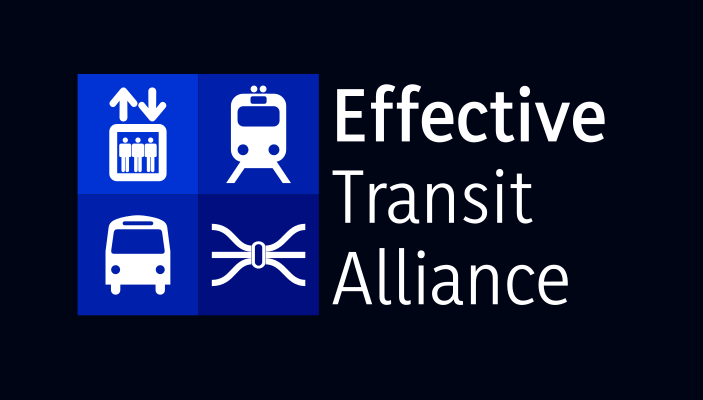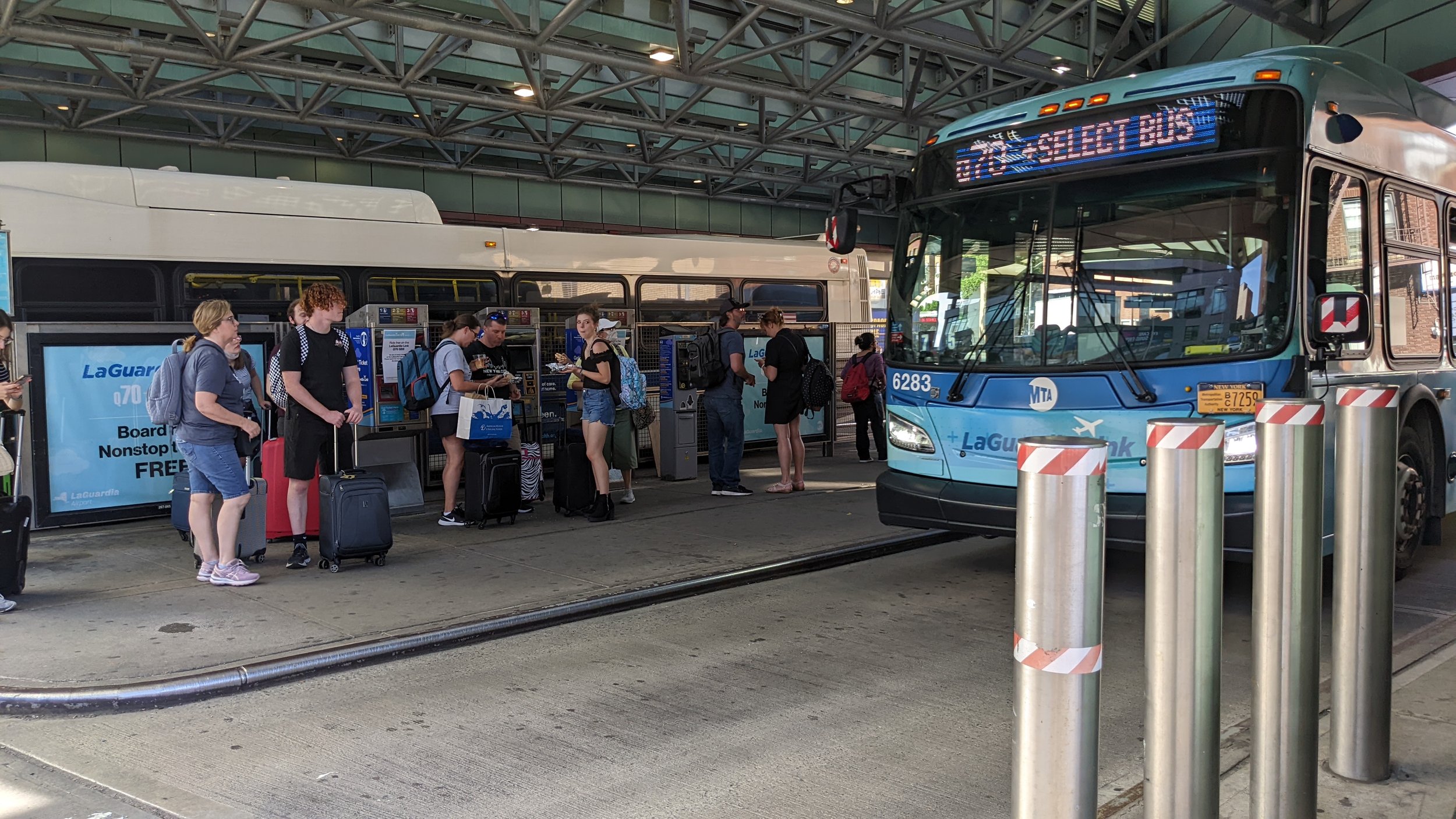
Mass Transit to LaGuardia Airport
Overview
The Port Authority of New York and New Jersey is currently reevaluating alternatives to improve transit service to LaGuardia Airport. The new alternatives analysis should favor alternatives with the greatest passenger benefits, cost-effectiveness, and improvement to the transit network as a whole. The Effective Transit Alliance supports dedicated bus lanes for existing bus routes and an extension of the Astoria Line (N/W) via 31st Street and 19th Avenue.
Bus lanes to LGA
To provide frequent and reliable service as quickly and cheaply as possible, we support dedicated bus lanes for the M60 and Q70 buses on the existing roadway surface. Dedicated bus lanes make service reliable by freeing them from the delays and unpredictability caused by traffic. In San Francisco, dedicated lanes for buses on Van Ness Avenue led to a reduction in trip times of 35% and a ridership increase of 15%. In addition to better rider experience, speeding up buses would also allow the MTA to run increased frequency on both routes, since the same number of drivers could make more round trips during the same time period.
The current Q70 Select Bus Service to LaGuardia Airport is well-used, and would be even more so with dedicated bus lanes
High-quality, physically separated bus lanes — like this example in the Bronx — would ensure a quick, reliable trip for airport travelers
Widening the Brooklyn-Queens Expressway and Grand Central Parkway would not be necessary to support dedicated bus lanes for either route. With the sole exception of entrance and exit ramps, the existing roadway could support both a bus-only lane and one or more general travel lanes. Despite carrying fewer vehicles, bus lanes have much higher capacity than general travel lanes, so converting an existing lane would increase, not decrease, the capacity of the roadway. Removal of cars from local roadways is a stated goal of the project; widening the roadway to maintain the existing number of general travel lanes would also maintain current vehicle capacity and therefore not achieve this goal. Travel volume is well known to respond to changes in capacity.
We also applaud Governor Hochul’s decision to make the Q70 free for all riders. This will save time on trips due to reduced boarding time at stations, and will reduce friction for passengers arriving at LaGuardia.
The subway extension option
Bus lanes can be implemented very quickly, but they remain much slower, less comfortable to ride, and less reliable than subway service. Not for nothing, the ridership on the four-station Second Avenue Subway Phase 1 on the eve of the pandemic was already three times higher than that of the M15 bus down the entirety of First and Second Avenues. The MTA must begin planning and design work on a rail extension to LGA immediately, in the hopes that if it starts to work on it now, it can open for service in the early 2030s.
The best option for a rail link to the airport is a subway extension of the Astoria Line along 31st Street and 19th Avenue. We are glad that this option is included among the alternatives to be studied and hope that it will be selected for medium- and long-term access. It has all of the following advantages:
The currently proposed subway extension, without intermediate stops
It offers a one-seat ride from the airport to many stations in Midtown, which is by far the dominant destination for LGA travelers. For airport travelers with luggage, transfers are particularly inconvenient.
It offers a two-seat ride to the Upper East Side, which is the second most popular destination for LGA travelers.
The Astoria Line has bumper tracks at its terminal, constraining rush hour capacity to a train every four minutes. By comparison, the 7 train terminal at 34th Street–Hudson Yards allows for a train every two minutes. An extension automatically fixes this issue and permits NYCT to run more trains.
There’s one more advantage of a subway option, not studied in the analysis yet. We urge the MTA to build a subway extension of the Astoria Line not as a nonstop ride between Astoria-Ditmars and the airport, but with intermediate stops such as Steinway and Hazen Streets. Some of these stops should serve Astoria Heights, which has existing density far from the subway; others should serve the area around 31st/19th, currently a Con Edison peaker plant, which can be redeveloped as a high-density residential area less than 20 minutes from Midtown.
We suspect the MTA omitted this option because FAA money could historically only be used for airport-only trips. An extension could only get FAA funding for the segment between the last non-airport stop and the airport. However, the Biden administration has recently abolished this rule, so that FAA grants can be used for an extension serving both airport trips and intermediate neighborhoods. The MTA should take advantage of this and build a better LGA subway extension.
Why not other options?
The alternatives analysis includes three new Bus Rapid Transit (BRT) routes, which would act as bus shuttles from the airport to various subway stations. These routes would duplicate rather than enhance existing bus service, so they would not improve connectivity from the airport to traveler destinations. We instead support BRT-style improvements along the Q70 and M60 routes. Similarly, the proposed light rail shuttles would not provide substantially greater connectivity than the existing bus routes, because they would still force most passengers to transfer.
The analysis studies another rail option in which the subway would branch off the Astoria Line near Astoria Boulevard station and run above the Grand Central Parkway. Under this scenario, LGA and Astoria-Ditmars would each get half as much frequency. This would be a service cut to the busiest station on the Astoria Line, which a direct extension from Astoria-Ditmars avoids.
Ferries offer a scenic option to passengers, but they are not a good solution for the expected high volumes of travelers trying to reach the airport. Ferries have much higher operating costs than rail or even buses. They also provide the worst connectivity to the subway network of all of the options. Since most travelers are heading into the Manhattan core, we should build an option that provides such connectivity.
The Port Authority should not use this project as an opportunity to experiment with emerging technologies. To guarantee passenger benefits as quickly as possible, we should implement proven solutions that integrate into the existing transit network. Emerging technologies have huge amounts of risk associated with them, and we cannot afford to take that risk.
Conclusion
The originally proposed “backwards” AirTrain would have been expensive while also not meeting travelers’ needs
The reevaluation of LaGuardia transit alternatives is a positive step. Based on the superior speed, capacity, frequency, and overall connectivity it would enable, an extension of the Astoria Line to the airport is the best long-term solution for travelers, airport employees, and residents of Queens. In the meantime, implementing dedicated lanes for the bus routes that link LaGuardia to the subway system would improve connectivity and reliability for a relatively low cost.




